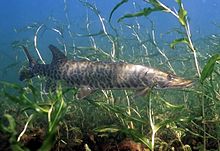Muskelunge
| Muskellunge | |
|---|---|
 |
|
| Scientific classification | |
| Kingdom: | Animalia |
| Phylum: | Chordata |
| Class: | Actinopterygii |
| Order: | Esociformes |
| Family: | Esocidae |
| Genus: | Esox |
| Species: | E. masquinongy |
| Binomial name | |
|
Esox masquinongy Mitchill, 1824 |
|
The muskellunge (Esox masquinongy), also known as muskelunge, muscallonge, milliganong, or maskinonge (and often abbreviated "muskie" or "musky"), is a species of large, relatively uncommon freshwater fish native to North America. The muskellunge is the largest member of the pike family, Esocidae. The common name comes from the Ojibwa word maashkinoozhe, meaning "ugly pike", by way of French masque allongé (modified from the Ojibwa word by folk etymology), "elongated face." The French common name is masquinongé or maskinongé.
The muskellunge is known by a wide variety of trivial names including Ohio muskellunge, Great Lakes muskellunge, barred muskellunge, Ohio River pike, Allegheny River pike, jack pike, unspotted muskellunge, and the Wisconsin muskellunge.
Muskellunge closely resemble other esocids such as the northern pike and American pickerel in both appearance and behavior. Like the northern pike and other aggressive pikes, the body plan is typical of ambush predators with an elongated body, flat head, and dorsal, pelvic, and anal fins set far back on the body. Muskellunge are typically 28–48 in (71–122 cm) long and weigh 15–36 lb (6.8–16.3 kg), though some have reached up to 6 ft (1.8 m) and almost 70 lb (32 kg). According to past references the muskellunge attains 8 feet (244 cm) in length; this, however, has never been confirmed and is based most likely on exaggerations. A fish with a weight of 61.25 lb (27.8 kg) was caught in November 2000 in Georgian Bay, Ontario. The fish are a light silver, brown, or green, with dark vertical stripes on the flank, which may tend to break up into spots. In some cases, markings may be absent altogether, especially in fish from turbid waters. This is in contrast to northern pike, which have dark bodies with light markings. A reliable method to distinguish the two similar species is by counting the sensory pores on the underside of the mandible. A muskie will have seven or more per side, while the northern pike never has more than six. The lobes of the caudal (tail) fin in muskellunge come to a sharper point, while those of northern pike are more generally rounded. In addition, unlike pike, muskies have no scales on the lower half of their opercula.
...
Wikipedia

